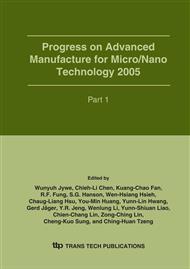p.841
p.847
p.853
p.859
p.865
p.871
p.877
p.883
p.889
A Pulse DC Plasma Deposited Resistor Process
Abstract:
The pulse DC plasma system offers so highly instant power to generate extremely intense plasma density that its applications are widely extended. In this work, the development of pulse DC plasma processing is studied for the sheet resistors, and the manufacturing mechanism relative to the properties of copper particles deposited on plastic materials is discussed by using atomic force microscopy and line-resistance measured technique.
Info:
Periodical:
Pages:
865-870
Citation:
Online since:
January 2006
Authors:
Keywords:
Price:
Сopyright:
© 2006 Trans Tech Publications Ltd. All Rights Reserved
Share:
Citation:


